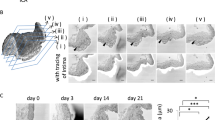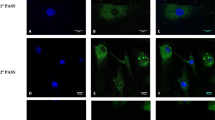Abstract
Background
Smooth muscle cells (SMCs) play a critical role in the vascular wall and also participate in vascular repair mechanisms. Dysfunction of SMCs may also contribute to the formation of intracranial aneurysms (IAs) causing subarachnoid hemorrhage. Our aim was to investigate the possibility of using cultured SMCs as an in vitro model for the study of aneurysmal SMCs.
Methods
IA tissue was obtained during microsurgical ligation of IAs. By using the explant method, cell cultures were established from the aneurysmal tissue. The phenotype of cultured cells from passage to passage was studied using immunoperoxidase staining and Western blotting. Eight cell lines could be established from 29 IA samples. Four lines showing most rigorous growth were investigated more thoroughly.
Results
Abundant expression of SMC markers, α-smooth muscle cell actin and calponin, as well as of prolyl-4-hydroxylases, a key enzyme family in the synthesis of collagens, was observed in all of them. Aneurysmal SMCs in culture maintained their phenotype and SMC characteristics through the early passages of growth.
Conclusion
This is the first documented successful culture of SMCs from human IAs. An access to living human cells of aneurysmal origin gives us a new tool in our research of the formation, growth, and rupture of IAs.



Similar content being viewed by others
Abbreviations
- αSMA:
-
α-smooth muscle cell actin
- DMEM:
-
Dulbecco’s modified Eagle’s medium
- IA:
-
intracranial aneurysm
- P4H:
-
prolyl-4-hydroxylase
- PBS:
-
phosphate-buffered saline
- PFA:
-
paraformaldehyde
- SDS:
-
sodium dodecyl sulfate
- SMC:
-
smooth muscle cell
- WB:
-
Western blotting
References
Boscolo E, Pavesi G, Zampieri P, Conconi MT, Calore C, Scienza R, Parnigotto PP, Folin M (2006) Endothelial cells from human cerebral aneurysm and arteriovenous malformation release ET-1 in response to vessel rupture. Int J Mol Med 18:813–819
El-Mezgueldi M (1996) Calponin. Int J Biochem Cell Biol 28:1185–1189
Feigin VL, Rinkel GJ, Lawes CM, Algra A, Bennett DA, van Gijn J, Anderson CS (2005) Risk factors for subarachnoid hemorrhage: an updated systematic review of epidemiological studies. Stroke 36:2773–2780
Frösen J, Piippo A, Paetau A, Kangasniemi M, Niemelä M, Hernesniemi J, Jääskeläinen J (2004) Remodeling of saccular cerebral artery aneurysm wall is associated with rupture: histological analysis of 24 unruptured and 42 ruptured cases. Stroke 35:2287–2293
Frösen J, Piippo A, Paetau A, Kangasniemi M, Niemelä M, Hernesniemi J, Jääskeläinen J (2006) Growth factor receptor expression and remodeling of saccular cerebral artery aneurysm walls: implications for biological therapy preventing rupture. Neurosurgery 58:534–541
Furness SG, McNagny K (2006) Beyond mere markers: functions for CD34 family of sialomucins in hematopoiesis. Immunol Res 34:13–32
van Gijn J, Kerr RS, Rinkel GJ (2007) Subarachnoid haemorrhage. Lancet 369:306–318
Hao H, Gabbiani G, Bochaton-Piallat ML (2003) Arterial smooth muscle cell heterogeneity: implications for atherosclerosis and restenosis development. Arterioscler Thromb Vasc Biol 23:1510–1520
Juvela S (2002) Natural history of unruptured intracranial aneurysms: risks for aneurysm formation, growth, and rupture. Acta Neurochir Suppl 82:27–30
Kim HR, Appel S, Vetterkind S, Gangopadhyay SS, Morgan KG (2008) Smooth muscle signalling pathways in health and disease. J Cell Mol Med 12:2165–2180
Laaksamo E, Tulamo R, Baumann M, Dashti R, Hernesniemi J, Juvela S, Niemelä M, Laakso A (2008) Involvement of mitogen-activated protein kinase signaling in growth and rupture of human intracranial aneurysms. Stroke 39:886–892
Li S, Fan YS, Chow LH, Den Diepstraten V, van Der Veer E, Sims SM, Pickering JG (2001) Innate diversity of adult human arterial smooth muscle cells: cloning of distinct subtypes from the internal thoracic artery. Circ Res 89:517–525
Myllyharju J (2003) Prolyl 4-hydroxylases, the key enzymes of collagen biosynthesis. Matrix Biol 22:15–24
Nakajima N, Nagahiro S, Sano T, Satomi J, Satoh K (2000) Phenotypic modulation of smooth muscle cells in human cerebral aneurysmal walls. Acta Neuropathol 100:475–480
Newman PJ, Newman DK (2003) Signal transduction pathways mediated by PECAM-1: new roles for an old molecule in platelet and vascular cell biology. Arterioscler Thromb Vasc Biol 23:953–964
Owens GK, Kumar MS, Wamhoff BR (2004) Molecular regulation of vascular smooth muscle cell differentiation in development and disease. Physiol Rev 84:767–801
Pera J, Korostynski M, Krzyszkowski T, Czopek J, Slowik A, Dziedzic T, Piechota M, Stachura K, Moskala M, Przewlocki R, Szczudlik A (2010) Gene expression profiles in human ruptured and unruptured intracranial aneurysms: what is the role of inflammation? Stroke 41:224–231
Rocnik EF, Chan BM, Pickering JG (1998) Evidence for a role of collagen synthesis in arterial smooth muscle cell migration. J Clin Invest 101:1889–1898
Rzucidlo EM, Martin KA, Powell RJ (2007) Regulation of vascular smooth muscle cell differentiation. J Vasc Surg 45(Suppl A):A25–A32
Takemura Y, Hirata Y, Sakata N, Nabeshima K, Takeshita M, Inoue T (2010) Histopathologic characteristics of a saccular aneurysm arising in the non-branching segment of the distal middle cerebral artery. Pathol Res Pract 206:391–396
Tulamo R, Frösen J, Junnikkala S, Paetau A, Pitkäniemi J, Kangasniemi M, Niemelä M, Jääskeläinen J, Jokitalo E, Karatas A, Hernesniemi J, Meri S (2006) Complement activation associates with saccular cerebral artery aneurysm wall degeneration and rupture. Neurosurgery 59:1069–1076
Tulamo R, Frösen J, Junnikkala S, Paetau A, Kangasniemi M, Peláez J, Hernesniemi J, Niemelä M, Meri S (2010) Complement system becomes activated by the classical pathway in intracranial aneurysm walls. Lab Invest 90:168–179
Uranishi R, Baev NI, Kim JH, Awad IA (2001) Vascular smooth muscle cell differentiation in human cerebral vascular malformations. Neurosurgery 49:671–679
Van Den Diepstraten C, Papay K, Bolender Z, Brown A, Pickering JG (2003) Cloning of a novel prolyl 4-hydroxylase subunit expressed in the fibrous cap of human atherosclerotic plaque. Circulation 108:508–511
Walker DG, Dalsing-Hernandez JE, Lue LF (2008) Human postmortem brain-derived cerebrovascular smooth muscle cells express all genes of the classical complement pathway: a potential mechanism for vascular damage in cerebral amyloid angiopathy and Alzheimer’s disease. Microvasc Res 75:411–419
Wang Z, Rao PJ, Shillcutt SD, Newman WH (2003) Phenotypic diversity of smooth muscle cells isolated from human intracranial basilar artery. Neurosci Lett 351:1–4
Conflicts of interest
None.
Author information
Authors and Affiliations
Corresponding author
Rights and permissions
About this article
Cite this article
Bygglin, H., Laaksamo, E., Myllärniemi, M. et al. Isolation, culture, and characterization of smooth muscle cells from human intracranial aneurysms. Acta Neurochir 153, 311–318 (2011). https://doi.org/10.1007/s00701-010-0836-x
Received:
Accepted:
Published:
Issue Date:
DOI: https://doi.org/10.1007/s00701-010-0836-x




